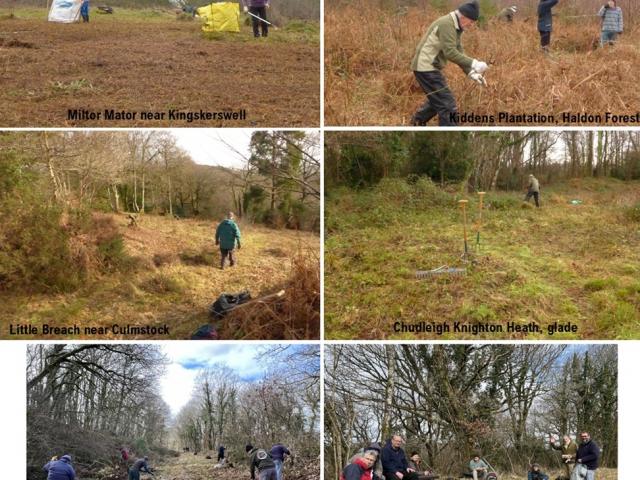
Interested to see what goes on at our Branch Events? Scroll down below for a series of short reports from our Events. You can also find more information in our Newsletters.
Conservation work parties in January and February 2023

January 8th: Teignbridge Heathfield Reserve – Coppicing and clearing was undertaken at the reserve adjacent to Bovey Heath. In the last two years, small numbers of Silver-studded Blue butterfly have been seen on the Heath, and it is hoped that the butterfly may find its way back into Heathfield Reserve where it used to breed. Six people attended and although useful work was accomplished, the task was shortened by incoming rain.
January 15th: Chudleigh Knighton Heath, old railway area. Six people opened up a glade which Pearl-bordered Fritillary is known to frequent. Bramble and saplings were cleared. Patches of Dog Violet, the butterfly’s larval foodplant, were found.
January 28th: Kidden’s Plantation, Haldon - A day organised by Jenny Plackett. Twelve volunteers removed saplings (mainly with tree poppers) and raked holes in the standing dead bracken to create breeding areas for Pearl and Small Pearl-bordered Fritillary. Tim Powles from the Forestry Commission attended and had brought hot drinks and doughnuts for the volunteers to consume. In addition Jenny brought packets of biscuits to help keep the workers’ energy up!
February 5th: Little Breach near Culmstock - Previously brushcut vegetation was raked and disposed of by eight attendees. A few people involved with Blackdown Hills AONB were present. Max Anderson, BC Ecologist, found us a Purple Hairstreak egg on an oak twig.
February 11th: A private Marsh Fritillary site at Buckland in the Moor was worked on by nine volunteers. Rhos pasture was cleared of young saplings (using sapling pullers) and mature trees were trimmed to increase the butterfly’s breeding area.
February 18th: Miltor Mator near Kingskerswell – Twelve BC volunteers raked up cuttings left from the operation of a Roboflail which Aggregates Industries along with Pete Beale had hired beforehand. The remotely operated machine munches through scrub leaving the ground cleared. The work should benefit the rare Grizzled Skipper which persists in good numbers at the site. Attendees enjoyed a dry day.
February 25th: Lydford Old Railway Reserve – Nine volunteers raked up previously brushcut vegetation and the long branch polesaw was used to fell overhanging branches to increase incoming light. Some felled oak branches were checked for Purple Hairstreak eggs and several were found.
(Pete Hurst - BC volunteer)
Lydford Old Railway Reserve work party - Saturday 19th November 2022
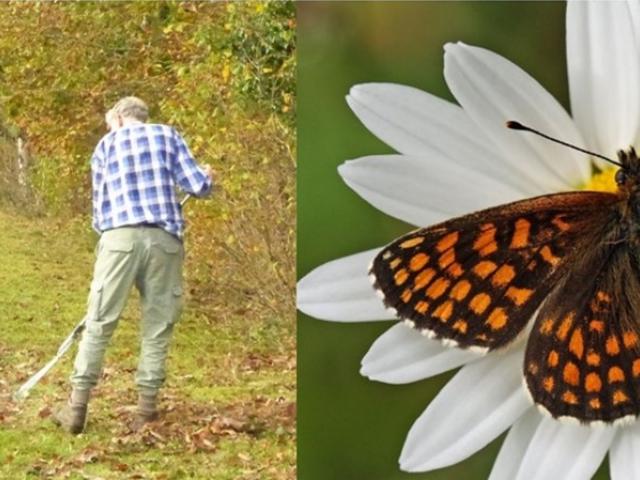
A work party of 6 people from Devon BC spent a half day raking up on the Old Railway Reserve where the brushcutter had been the day before. The clearance work is essential for the Heath Fritillary for which the Reserve is the site of the only remaining Devon colony.
Luckily it remained dry after quite a wet week, and we even saw a Red Admiral at the start of the task when it was sunny. Some pole-sawing of high overhanging branches was done after the raking was complete along with other coppicing of branches growing into the reserve.
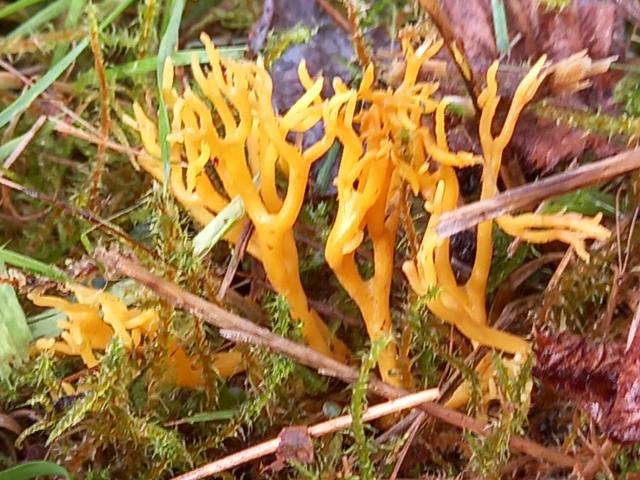
Paul Butter found an uncommon fungus in the grassland: Clavaria corniculata, which is an indicator of unimproved grassland often found in woodland clearings.
(Pete Hurst - BC volunteer)
Chudleigh Knighton Heath work party - Sunday 13th November 2022
An eight-strong work party coppiced a small area near Dunley Cross on Chudleigh Knighton Heath, principally for Pearl-bordered Fritillary which is present on the Heath in small numbers. Small trees, shrubs and brambles were cut down low to the ground. The area coppiced is around some concrete hard stands surviving from the Second World War when American forces had a base on the Heath.
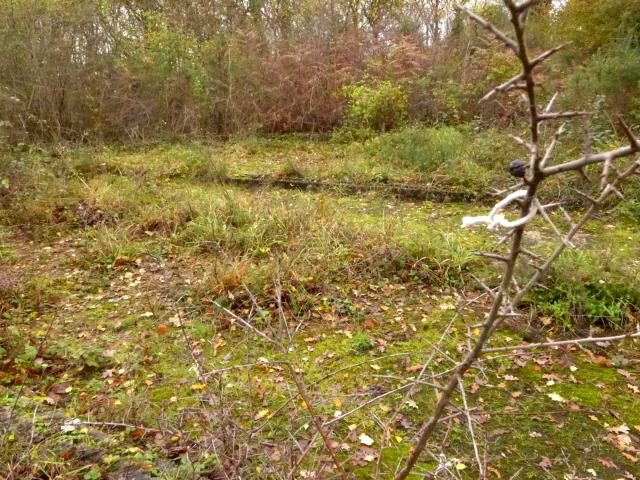
When coppiced it is a warm open space that Pearl-bordered prefers and Dog Violet, the larval foodplant, is present. Additionally Brown Hairstreak eggs are found in the same area every year. The Hairstreak benefits from the regrowth from coppiced Blackthorn preferring to egglay on this and we were careful to avoid coppicing plants which had the overwintering eggs on by marking the plants with small pieces of loosely tied white string (see photo). Some of the other older non-egg bearing Blackthorns were coppiced to provide fresh new growth for the Brown Hairstreak in ensuing years.
The weather was dry if rather dull and we substantially opened up this wildlife glade which was very satisfying. Members who attended came from Plymouth, Dartmouth, Ashburton, Newton Abbot, Liverton, Chudleigh and Exeter.
(Pete Hurst - BC volunteer)
Little Breach Reserve work party - Sunday 6th November 2022
Travelling from Chudleigh with Jonathan Aylett to Little Breach Reserve near Hemyock on 6th November 2022, the rain was continuous in spite of only showers of rain being predicted. Rain continued as we assembled with others at the parking area near Purchas Farm and also as we began our task about 20 minutes later. Fortunately rain finally let up within half an hour and then we enjoyed a sunny dry period for most of the remaining time at the reserve.
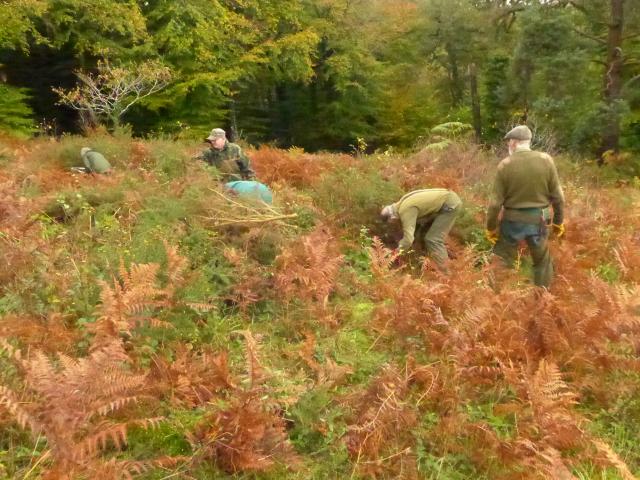
8 people in total attended and we were removing saplings and scrub from the grassland in the lower field. Abby Wilkinson, Community Engagement Ranger for the Blackdown Hills AONB came with a couple of her volunteers and others were from Devon BC. Abby kindly brought a large plastic box of refreshments and Rick Tillett, Little Breach Reserve Officer generously brought some delicious goodies, savoury and sweet that he had made himself which were most enjoyed by the party.
A good amount of work was done with all the cuttings gathered into piles and the area improved for butterflies and invertebrates as well as for ground flora. It is hoped that Small Pearl-bordered Fritillary is still present along with the many grassland butterflies including Marbled White.
A second work day at Little Breach is scheduled for Sunday 5th February 2023.
(Pete Hurst - BC volunteer)
Ashclyst Forest work party - Saturday 22nd October 2022
Organised by Peter Beale, we were shown the work site by the National Trust Forester, John Herbert. A belt of 2 year old willows was to be coppiced low to the ground next to a track in an area previously used by early fritillaries, namely Pearl-bordered and possibly Small Pearl-bordered Fritillary. As we coppiced we found Dog Violets, the butterflies’ larval foodplant beneath, so a good sign. Immediately adjacent to the track was a narrow belt of year-old willow which the forester asked us to leave to be tackled by machine later.
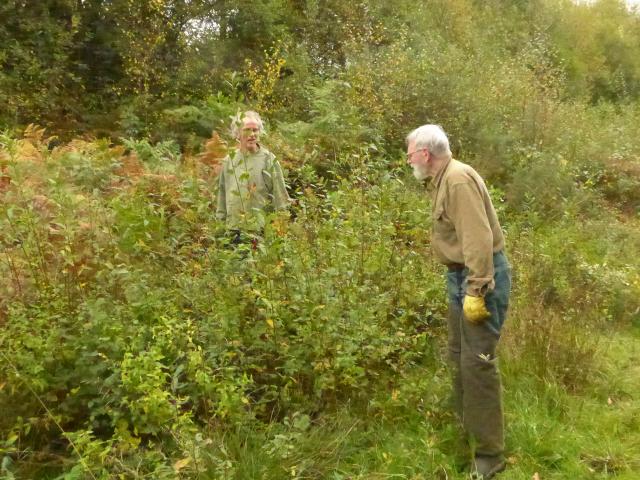
The weather was kind enough, being mainly dry and holding off from more frequent showers which came after we finished.
The early fritillaries have survived at Ashclyst in low numbers in recent years, and during the summer Malcolm Jarvis told me that unfortunately no Pearl-bordereds had been seen at Ashclyst in 2022. However, in my experience this very mobile species can easily be missed and can persist in low numbers for a period of time, so hopefully they are still there. Ashclyst is their most easterly outpost in Devon, and I hope the butterfly recovers in numbers.
4 members attended, 2 from East Devon including Branscombe and the others were from Newton Abbot and Chudleigh.
(Pete Hurst - BC volunteer)
Bovey Heathfield - Sunday 27th January 2019
A very windy day made our job of raking up the dead grass rather difficult and volunteer numbers were down on our usual turnout here. But we still managed to do some significant work and our leader, Pete Hurst, was very pleased that we had opened up and cleared out many small areas that had become clogged up with bramble and dead grass around and within the gorse and heather bushes. This will give the sun access to warm up the ground later in the year.
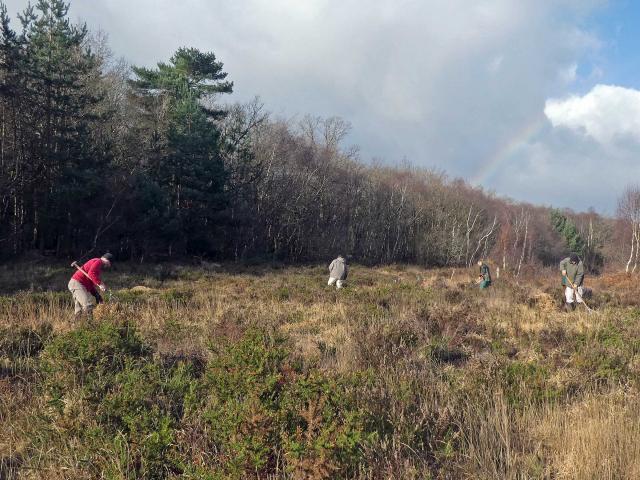
Although the Silver-studded Blues were not recorded onsite in 2018 patches of open ground favour a number of our local butterflies (and other wildlife) and it important to keep this small site in good condition and fight back on the constant scrub encroachment. An ant survey of the site was been done in 2018 (the presence of ants is thought to be beneficial to the larvae) and during 2019 we will once again monitor the site for the Silver-studded Blue.
Many thanks to Pete and the hardy few volunteers who turned up! It was not all work! Lunch time gave us a chance to sit down and have a good discussion about moths and moth traps – I always learn something from other attendees of these workdays and this day was no exception.
(Amanda Hunter - BC volunteer)
Miltor Mator - Saturday 19th January 2019
A good turnout of volunteers ignored the wet weather forecast and enjoyed an unexpectedly sunny day clearing scrub at Miltor Mator Common near Newton Abbot. This site is home to a colony of Grizzled Skipper and we made sure we left plenty of areas of low bramble which are good for the larvae of this species on this site. There was a big welcome from all of us to Simon Wiltshire, Biodiversity and Restoration Advisor at Aggregate Industries, who also came along to help oversee the work and who also did some of the heavier work with chainsaw etc.
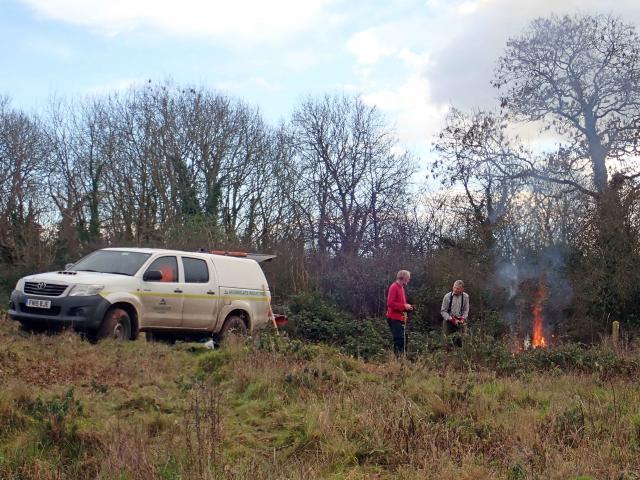
Members who might be curious about what happens (and what they would be expected to do) on our workdays can be re-assured that we all work as slowly (or as fast) as we each feel comfortable with. Personally I need to take lots of breaks and others just join in for the morning or the afternoon. Some people love to cut down heavy branches and others (like me) just deal with the small stuff. It all helps!
A big thank you to Pete Hurst who has organised this and many of our winter workdays this year and to everyone who came along.
(Amanda Hunter - BC volunteer)
Haldon Butterfly Walk near Exeter work day - Saturday 1st December 2018
Hosted by the Forestry Commission, the day was organised by Jenny Plackett, BC’s South West Regional Officer. Fortuitously, overnight rain cleared just in time and the day was fine and bright. 8 members attended including Jenny. The main work was for the benefit of Grizzled Skipper: one of the short cross-paths was cleared back from encroaching scrub and bramble to expose more bare warm ground that the butterfly needs. It is planned that Forestry Commission work will brushcut or scarify the area we cleared to reduce everything to ground level. One of the few records of Grizzled on Haldon reported this year was on this path. Dingy Skipper and Common Blue similarly favour warm ground.
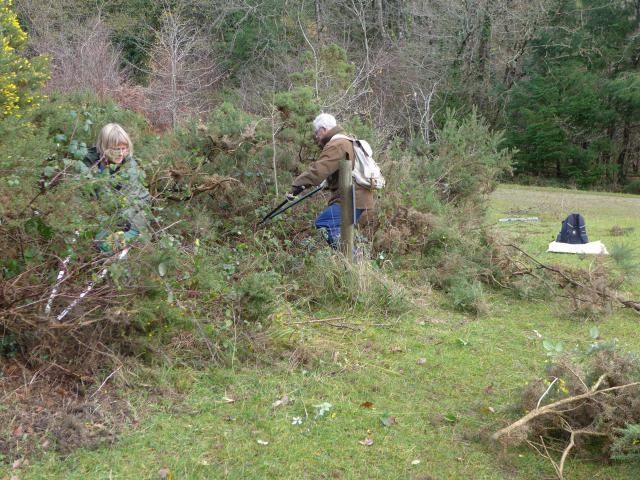
Other work we did was clearing small trees from the fritillary breeding area. Jenny again brought some tree poppers which lever small trees out of the ground whole, which is a more permanent clearing method than coppicing, whereby the trees regenerate from the coppiced stool.
(Pete Hurst - Newsletter Editor, Winter Work Party Co-ordinator)
Ashclyst Forest near Exeter work party - 25th November 2018
This was Devon branch’s first work party at this site as far as I am aware. The weather was ideal, dry and fine with occasional sunny spells and temperature circa 9C.
Only 3 BC members turned up, which was a little surprising for an event near Exeter, but fortunately 2 members from the National Trust including warden Phil Stuckey and one other person bolstered numbers to 6.
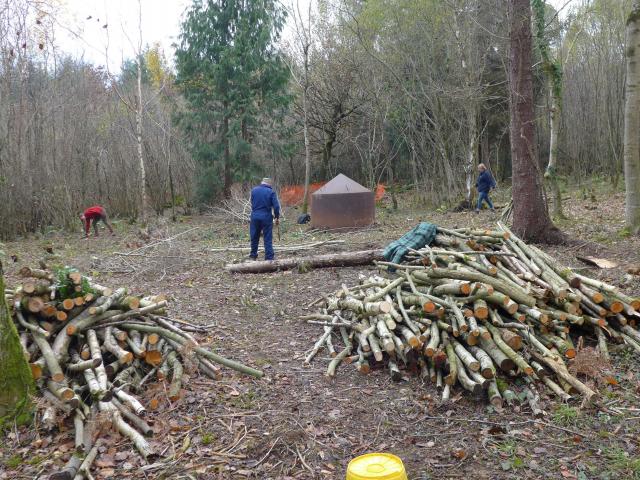
Ashclyst is a great place in summer for Silver-washed Fritillary and White Admiral, but also has small numbers of Pearl-bordered Fritillary in springtime which comprise the most easterly population of the species in Devon. Our work was coppicing trees on Snaffle Park Drive to expose the forest floor with bountiful violets, the caterpillar foodplant and other flowering herbs that would provide nectar for the adult butterflies during the flight period. Close to where we were working there was a charcoal kiln which is used by the National Trust to process coppiced wood on site and convert it to charcoal which is then sold in their shop at nearby Killerton House.
With only a small team of workers we did the best we could and Phil was pleased that we had widened the glade amongst the trees to create more potential fritillary habitat. Some of the brash from the coppiced trees was used to cover the coppiced stumps as deer are known to quickly nibble off any exposed fresh shoots.
(Pete Hurst - Newsletter Editor, Winter Work Party Co-ordinator)
Lydford Old Railway Reserve work day - 17th November 2018
Fine weather greeted us at Lydford as we arrived - other parts of Devon had begun with drizzle. 9 of us completed the necessary raking up after the strimmer in the first 2 sections with 2 members also doing some coppicing work in section one. A few overhead branches were sawn down with the branch pole saw to increase light on the reserve.
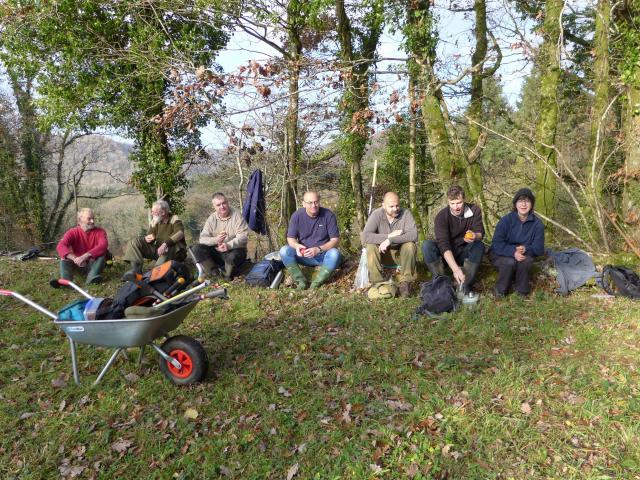
Once again, our brushcutting contractor had done a thorough job of strimming down the vegetation. It is planned for the contractor to spend an extra day or two this winter doing more clearance work at the end of the reserve (section 4) to further open that section up as available habitat for Heath Fritillary.
(Pete Hurst - Newsletter Editor, Winter Work Party Co-ordinator)
Devon BC work day at Teigngrace Meadow DWT Reserve - 4th November 2018
The weather forecast did not bode well for this event which is probably why only 2 people were present – myself and Andy Bakere, the reserve warden.
We decided to proceed to the site which sits northeast of the almost adjacent Stover Country Park near Newton Abbot and do some work in the initially reasonably dry conditions, but we hadn’t long got started when the weather began to go downhill with steady drizzle. We tolerated the wet conditions until lunch time then called it a day.
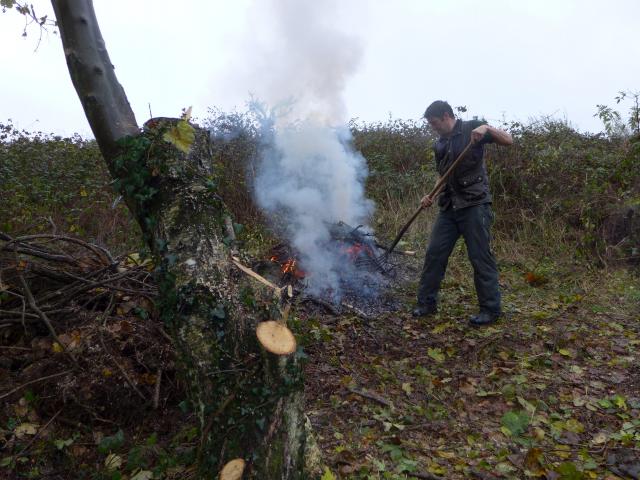
A large Birch tree near to a previously cleared area was felled by chainsaw by Andy and we both then cut it into smaller pieces to feed a compact fire that Andy managed to get going. Andy explained that he was keen to make an impact on scrub clearing on the site to maintain the special grassland environment – the site is exceptionally good for Green-winged Orchid as well as many butterfly species. It is planned to have grazing animals on site soon and Devon Wildlife Trust will need to pump water from the nearby river Bovey to a storage area on the plateau.
(Pete Hurst - Newsletter Editor, Winter Work Party Co-ordinator)
Haldon Butterfly Walk management for early Fritillaries - Feb 4th 2018
Organised by Jenny Plackett, BC South West Regional Officer, BC volunteers met in Haldon Forest Park car park. Travelling in as few cars as possible down to park on a track next to the Butterfly Walk, 14 of us, including 3 Forestry Commission staff then walked the few metres to the work site, a south-facing slope beneath the main electricity power line for the southwest. Historically, because the power line needs to be kept clear of mature trees, the long slope has been managed to keep vegetation short and Pearl and Small Pearl-bordered Fritillaries have thrived as a result.
Here Jenny explained in detail the aim of the management. Early instar Pearl-bordered Fritillary larvae would still be quite deep down in the bracken-dominated grassland ground litter safe from frost, but very soon in increasingly warmer temperatures they would surface and continue feeding on Dog Violet leaves. In order to be on the wing by as early as the second half of April, sheltered pockets of exposed ground where the Dog Violets are would assist quick growth of the larvae. Thin bracken litter peppered about on the ground would help absorb the sun’s rays and increase ambient temperature in the pockets by perhaps 10 – 15 C.
Volunteers raked away dead bracken looking for areas with violets trying to create hot spots for the larvae. The dead bracken rakings along with tree saplings were removed and stacked on the shady slope of the nearby conifer crop. Small Pearl- bordered butterflies would also benefit, though they seem less dependent on the hottest ground conditions.
“Tree Poppers” were in use – they efficiently grab small trees at their base and then can be levered out which is better than coppicing whereby the trees quickly re-grow. Much good work got done, and as the event was well attended there was time for plenty of chats and networking.
(Pete Hurst - Newsletter Editor, Winter Work Party Co-ordinator)
Little Breach Blackdown Hills work day - 28th Jan 2018
A better turn out this time of 6 people (only 3 last year) on a generally fine mild day with some patchy drizzle on arrival and at the end. Main task was raking up the cut lower grassy slope with a secondary task of clearing the fence lines of bramble and bracken.
John Bell, the reserve officer, showed us some impressive patches of Devil’s-bit Scabious which in recent years has suddenly become more prevalent. He has made sure that the winter cut has not cut too low into these. Last year he said that on one day 85 Red Admirals had been seen on this late flowering Scabious.
Frog spawn was seen in the small excavation at the bottom of the site and Pete Hurst found a Sloe Bug crawling on his clothing that had appeared from somewhere.
(Pete Hurst - Newsletter Editor, Winter Work Party Co-ordinator)
DWT Teigngrace Meadow - 26th Nov 2017
You can see from the photo how much work was done by our volunteers on this winter work day! Two great swathes of this slope were cleared of scrub and a big thank you to some new volunteers as well as our regulars. The cycle bridge in the photo connects this DWT reserve with the north side of the A38 and we recommend members check out this south facing slope (and the rest of the reserve) in the summer to see what butterflies can be seen. However, do mind the ditch in front of the slope, a couple of us got water in our wellies as we found out how deep it was!
Thanks to DWT Ranger Luca Bortali who led the conservation work and to BC Committee Member Pete Hurst who organised the day and was on duty as our First Aider. Despite it being November we saw various insects including a Peacock butterfly, a Violet Ground Beetle, a Bloody Nosed Beetle and a Gorse Weevil.
DWT Chudleigh Knighton - 5th Nov 2017
Our first winter work day of the season was a great success and we cleared two adjacent sections of habitat alongside northerly circuit track of this Devon Wildlife Trust reserve. As we cleared out the brambles and scrub we found violets growing underneath, showing that this is ideal habitat for the Pearl-bordered Fritillary butterflies that are recorded in small numbers onsite. Hopefully the improved habitat will help this PBF colony thrive and increase.
Once we had finished the clearance our workparty leader, Pete Hurst, showed everyone how to search for Brown Hairstreak butterfly eggs in the blackthorn. Another success! 16 eggs found and recorded.
Thanks to both the stalwart regulars and the new volunteers that turned up to help, a very enjoyable and productive day.
Andrew’s Wood moth event - 14 July 2017.
A total of 21 people attended, which was a good number. The evening was not particularly warm, so 2 traps were set up in the woodland and 1 in the open near the woodland edge. Jackie Gage led a walk around part of the reserve at dusk, while waiting for darkness to fall. The rare heath Lobelia were in flower and admired.
By the end of the evening a total of 86 species had been recorded, the most interesting being:
|
Alcis jubata |
Dotted Carpet |
|
Brachylomia viminalis |
Minor Shoulder-knot |
|
Catarhoe cuculata |
Royal Mantle |
|
Celypha aurofasciana |
a micro-moth |
|
Deileptenia ribeata |
Satin Beauty |
|
Epione repandaria |
Bordered Beauty |
|
Eudonia delunella |
a micro-moth |
|
Eulithis testata |
Chevron |
|
Euphyia unangulata |
Sharp-angled Carpet |
|
Hydrelia sylvata |
Waved Carpet |
|
Hydria undulata |
Scallop Shell |
|
Lampropteryx otregiata |
Devon Carpet |
There were also some “crowd pleasers” for those new to moth trapping such as:
|
Deilephila elpenor |
Elephant Hawk-moth |
|
Geometra papilionaria |
Large Emerald |
|
Ourapteryx sambucaria |
Swallow-tailed Moth |
|
Thyatira batis |
Peach Blossom |
Overall it was a most enjoyable evening with plenty of moths to see. Participants gradually left as the night moved on and we finally finished packing up at about 01:00. Thank you to Jackie Gage (Devon Wildlife Trust, reserves officer) for allowing us to hold the event and driving the equipment onto site.
(Barry Henwood, Branch Chair and County Moth Recorder)
Heddon Valley (BC Event) - 9th July 2017
Report by Branch Events Co-ordinator Paul Butter who led the walk
There was a disappointing turnout of only 2 BC members for this joint event with the British Naturalists Association who had 7 members attend, headed up by Brian Sims. It was sunny but blustery on the exposed parts of the walk which began at the National Trust car park at Hunters' Inn. Before reaching the main bracken covered slopes renowned for the High Brown Fritillary, we were met in the lane by a wheeling pair of Dark-green Fritillaries. Apparently, the High Browns had been “everywhere” a couple of weeks earlier so it seems the heat wave in June had caught us on the hop. Sure enough of the dozens of Fritillaries we saw on the slopes most were quite tatty and lost their golden colours. They were all flying at pace and only nectaring on bramble blossom very briefly making identification almost impossible.
Further along the cliff path we came across 3 or 4 Grayling (which were so cryptically camouflaged that even when pointed out a few feet away several of the group had trouble seeing them at rest) and 3 Humming-bird Hawk-moths. Overall species seen were Silver-washed Fritillaries, Purple Hairstreaks, Comma, Red Admiral, Painted Lady, Small Tortoiseshell, Meadow Brown, Ringlet, Small Skipper, Large Skipper, Small Copper and Holly Blue and the micromoth Ypsolopha ustella.
Bircham Valley Local Nature Reserve, Derriford, Plymouth, - 5th July 2017
A small group of members, led by BC member Dave Gregory, attended this mid-week excursion to Bircham Valley Local Nature Reserve, not visited before by Butterfly Conservation. Dave knew this to be a good spot, and we weren’t disappointed.
On a hot, sunny day we saw at least 13 butterfly species: large skipper, small skipper, green-veined white, speckled wood, meadow brown, marbled white, ringlet, gatekeeper, small tortoiseshell, comma, red admiral, silver-washed fritillary, common blue. There may also have been the large white or small white among the unidentified butterflies that we saw. What was especially enjoyable was to see some of these species in really good numbers.
The reserve provides a combination of meadows and woods, and we visited three meadows. Butterflies were particularly abundant in the largest of these, a nice flowery area on a slope. The highest density of butterflies was round this meadow’s edge where it bordered woodland.
Many thanks to Dave Gregory for organizing and leading this walk.
(Robert Powell, BC member)
Soar - 2nd July 2017
A big thank you to BC member John Rickett who offered to lead a butterfly walk on this wonderful bit of the South Devon coastline. It proved to be an excellent addition to the branch summer calendar.
The walk started at the East Soar NT car park we soon started seeing Meadow Browns, Skippers, Marbled Whites, Ringlets and several Small Coppers in the hedgerows. Once we were out on the Coast Path they were joined by some magnificent Dark Green Fritillaries weaving in and out of the meadow grasses and flowers growing in this beautiful spot.
All along the cliff path we saw Grayling and a couple of Small Pearl-bordered Fritillaries were spotted near Bolt Head. We also had the opportunity to see quite a number of Silver-studded Blues – including three mating pairs!
Everyone really enjoyed themselves and in total we saw 10 butterfly species. Thanks once again to John Rickett, who kept everyone so well informed about the various species we saw.
(Amanda Hunter, Branch Membership Officer)
White-letter Hairstreak Survey Workshop (BC Event) - 1st July 2017
Thanks to BC SW Senior Regional Officer Jenny Plackett and to Natural England Reserve Manager Albert Knott who jointly led this workshop and also to our Branch White-letter Hairstreak Champion John Rickett who attended and shared his local knowledge. The workshop offered some training to volunteers who were prepared to help survey for this rarely seen butterfly. White-letter Hairstreaks have been recorded in the Bovey Valley Woodlands in previous years and Natural England volunteers have already been mapping out the various elm trees in the locality.
Jenny Plackett reported that they did manage to see a couple of White-letter Hairstreaks on the day - on the elms close to the road by the right of the Pullabrook Wood car park entrance as you go into the car park.
Jenny has also provided some useful links for anyone interested in this species.
UK Butterflies – White-letter Hairstreak
Survey Tips and notes from the White-letter Hairstreak Project 2007-09 (BC & various BC Branches)
You can also download a BC booklet about the WLH here – lots of useful information.
Ashclyst Forest Sunday - 25th June 2017
Weather for the field event at Ashclyst on June 25th was rather cloudy but there were enough sunny spells to get some butterflies on the wing. The target species was the lovely White Admiral which is scarce in Devon and we were rewarded with about a dozen being seen and one or two that stopped long enough on Bramble blossom to get really good photos. Silver-washed Fritillaries were out in force, well over 30 looking magnificent as though they had just emerged. other highlights were a whirl of Scarlet Tiger moths in one particular spot where they seem to be year after year and a very interesting sighting of Four-spotted Footman moth larvae descending from the Oak canopy, where they had been feeding on lichens, on long silk threads to the ground where they pupate. Other butterflies included Meadow Browns, Ringlets, Commas, Red Admirals, Large and Small Skippers, Green-veined Whites, Speckled Woods and a Holly Blue. It was well attended with 7 members enjoying a very good day butterflying.
(Paul Butter, Branch Events Co-ordinator)
DWT Meeth Quarry Reserve (BC Event) - 4th June 2017
Report by Branch Events Co-ordinator Paul Butter who led the walk.
As the morning was looking grim with heavy rain it looked as if this event may have had to be cancelled, but by 1pm the sun miraculously appeared to lead on to a lovely sunny afternoon. Four optimists came along and a very good day was had by all. Over 50 Common Blues were seen, a welcome number as last year the species was barely seen at Meeth. Some diligent searching eventually located a couple of Green Hairstreaks. Over 30 Wood Whites were seen and the very unlikely egg-laying area noted where small Birds' foot trefoil plants were on very open ground with sparse rushes. One attendee managed to find a Dingy Skipper egg while we were searching for WW eggs and over 20 adult Dingy Skippers were spotted which was also a big increase on last year. Plenty of day-flying Burnet Companion moths which flew up everywhere. In all 12 species of butterfly and 7 moths were recorded.
Orley Common - 27th May 2017
The branch has previously visited Orley Common later in the summer but this year leader Pete Hurst decided to vary things and explore this wonderful limestone habitat in May as it would give members a chance to see a different range of fauna and flora as well as the first brood of the butterflies that we usually see in their second brood on the site in late summer.
Over 8 species of butterfly were seen (including Common Blue, Large Skipper, Small Copper & Holly Blue) but highlights of the day for the twelve attendees was probably the various moths including Straw Dot (see photo), Green Carpet, Rush Veneer, Silver Y, Yellow Shell, Silver Ground Carpet & Common Carpet. We also saw larvae of Spindle Ermine in their communal webs on Spindle. Another great interest was the flora – Greater Butterfly Orchids, Common Twayblade.
Brown Argus, one of the target species, was not seen on the day but it is notably elusive. If you see one on the site please make sure you let us know (See our latest sightings page for more information). Good numbers of the Brown Argus have so far been seen at Dawlish Warren and Braunton Burrows.
Thanks to Pete for organising and leading this event – it makes so much difference to go round a site with such an expert guide. Most members knew the various butterfly species we saw but everyone needed Pete’s help to name all the moths and the plants!
Dartmoor NPA Volunteer event – Becka Brook Valley – 12th March 2017
Devon BC members joined the Dartmoor National Park Second Sunday volunteers to help with scrub clearance in the Becka Brook Valley on Sunday 12th March 2017. This work was necessary to help improve the habitat for the rare Marsh Fritillary butterfly. DNPA Ranger Simon Lee led us all safely across some very damp ground to get to an area of even damper ground (Marsh Fritillary habitats on Dartmoor are generally pretty boggy!) where BC’s Simon Phelps led the conservation work as part of the ‘All The Moor Butterflies’ project.
The aim of the work was to open up corridors to help the Marsh Fritillaries to move around more freely between the various open boggy patches where they find the Devil’s Bit Scabious that their larvae need as their foodplant. This year’s event follows on from a similar work party last year and, after doing some serious work cutting and clearing trees and scrub, some of the volunteers walked into last year’s clearance site and were overjoyed to find three groups of Marsh Fritillary larvae (see photo) enjoying the warmer spring air. This means that last year’s conservation work was a real success! Many thanks to all the DNPA volunteers & staff, and the local commoners, for working so hard to keep this habitat in good condition for these rare butterflies and the many other species that thrive in the very special habitat.
Lydford Old Railway reserve - Sun 5th Mar 2017
In spite of an unpromising forecast, 9 people appeared in the Waterfall car park at Lydford for the work party on the Old Railway reserve. 2 people joined us from the Dartmoor Preservation Association which now has a copy of our work part dates. Luckily, gales and heavy showers held off until we had completed all the raking up of strimmed vegetation in half of the reserve. Colin Sargent, the leader for the day was very pleased with the turn out and that the work was all completed. Branches growing out from the edge of the site were also trimmed back in places. Finishing early afternoon, several of us took advantage of the National Trust cafe which was unexpectedly open in the car park and continued chatting over tea, coffee, hot chocolate and various desserts!
Little Breach - Sun 26th Feb 2017
It was disappointing to only get a couple of members at the Little Breach winter conservation work day on 26 Feb 2017 and the branch will welcome any input from members about how to encourage more members to volunteer to help out at this BC reserve next winter. However, those that attended did a great job and one of the attendees, Pete Hurst, reports that “the weather was kind to us with wet conditions holding off until we had finished”. In the photo Volunteer Reserve Warden, John Bell, is shown raking, with a number of stone clusters in the background. Pete says “These clusters have been made from scattered stones on the site and serve as available refuges for lizards and also can create hotspots by reflecting sunshine onto the grassland - Common Blue is known to lay eggs in close proximity of stones where ground temperature is increased.” Anyone interested in helping out on this BC Reserve in the future can find more details here and you can email the branch here.
Bovey Heathfield - Sun 19th Feb 2017
This was our second work day this winter on this site which is a Teignbridge Council owned nature reserve. BC Devon and Teignbridge have been collaborating for a number of years to conserve the habitat for a small colony of Silver-studded Blue butterflies and other heathland species. Silver-studded Blues are seen in good numbers in Devon at Bicton Common and Bolt Head (see our Key Sites page) but this colony has never been very large and now seems to be declining – so we hope all our hard work helps them have a better year in 2017.
Sunday’s work included raking and scrub clearance and also we did some work creating a scrape – a big patch of bare ground which acts as a warm basking area for the butterflies as well as helping diversify the vegetation. You can find more information about why and how to create scrapes on our scrapes factsheet.
Thanks to everyone who attended either of these workdays this winter at Bovey Heathfield. Some of the February attendees are seen in the photo having a welcome break at lunchtime. Thanks to workparty leader Pete Hurst for organising the day and also to Teignbridge Council rangers for the work they have done on this site during the winter months.
More information about Silver-studded Blues can also be found on our Silver-studded Blue factsheet.
Little Breach - Sun 22nd Jan 2017
A small number of volunteers turned out for day's conservation work on our Little Breach reserve and Pete Hurst reports that it was a lovely sunny day and that the vegetation was very dry, making raking an easy job! At tea break time everyone stopped to observe a minute's silence in memory of David Hinde, our Conservation Officer who sadly died in 2016 and who was our Branch Reserve Officer for Little Breach. David's wife has had a memorial bench installed at the reserve and in this photo volunteers John Bell (our new Little Breach Reserve Officer) and Jonathan Aylett are seen taking a short break from work.
Bovey Heathfield - Sun 15th Jan 2017
This site is being managed to try and increase the breeding population of Silver-Studded Blue onsite and many thanks to the branch members who turned up to help and also to Sian Avon, Senior Ranger, Teignbridge Council Green Spaces who directed the work. Everyone was very excited to use Tree Popper tools for the first time - they really work!
Branch Members Day - Sat 22nd Oct 2016
BC members enjoyed a range of excellent speakers at the annual Branch Members Day and AGM on Sat 22 Oct 2016, this photo is taken by BC National Executive Committee Chair Jim Asher who was one of the speakers.
